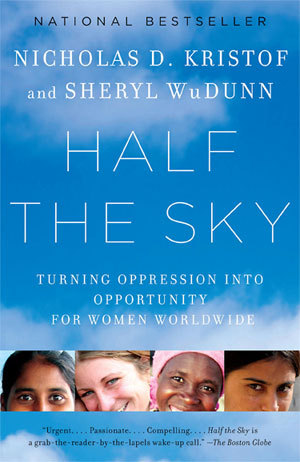
“Half the Sky: Turning Oppression into Opportunity for Women Worldwide” is a compelling narrative told in research form by Nicholas D. Kristof and Sheryl WuDunn, coworkers and also spouses.
“Half the Sky” talks about women worldwide but especially in Africa, India and the Middle East, and the horrors they still go through on a daily basis. These include, but are not limited to, beating, rape, trafficking, violence and death. Kristof and WuDunn choose to focus on four specific abuses: “sex trafficking and forced prostitution; gender-based violence, including honor killings and mass rape; and maternal mortality.”
They open their book with astounding, horrifying and disgusting statistics.
- Girls in India from one to five years of age are 50 percent more likely to die than boys the same age. This is because boys are taken to the doctor or hospital as soon as a problem occurs, whereas parents of girls are more likely to wait until the morning or the next day to see how the girl is, which is often too late.
- More girls have been killed in the last fifty years, precisely because they were girls, then men were killed in all the battles of the twentieth century. More girls are killed in this routine ‘gendercide’ in any one decade than people were slaughtered in all the genocides of the twentieth century.
- Maternal mortality claims one woman per minute. This is due to lack of proper health care, violence, and numerous other sources.
These startling statements made me feel sick–here I am in America, enjoying an iced coffee while reading this book, while hundreds of thousands of women and girls have probably never even had iced coffee, let alone are able to leisurely read a book.
Kristof and WuDunn intersperse their data with stories of women and girls they met and worked with in the field–horrendously violent and melancholy stories, but also stories of hope. Stories of women who were beaten, raped, sold into prostitution, blinded, forced to have abortions. But also stories of women who beat the odds, escaped from their torturers, and made a better life for themselves. Stories of agencies and individuals donating money and time to help these women. For what would Kristof and WuDunn’s data and research be worth if there wasn’t hope in the middle of it? If there weren’t solutions to be worked towards?
The authors offer a number of solutions and ways to reach them, but by far the most significant solution is the education of women. In so many places around the world, women are denied the ability to read and write and to go to school, thus denying them the ability to know their rights as human beings. Kristof and WuDunn propose that “educating girls is one of the most effective ways to fight poverty.”
There are a few other points the authors made that truly stuck with me. I will list them below and give some thoughts, but I would also love to hear yours.
- In general, the best clue to a nation’s growth and development potential is the status and role of women. A good example of this, surprisingly enough, is China. We don’t think of China when we think of gender equality–we generally think of female infanticide and foot-binding. But China is taking huge steps toward equality between the genders. For example, urban Chinese men typically involve themselves more in household tasks like cooking and childcare than most American men do.
- If we believe firmly in certain values, such as the equality of all human beings regardless of color or gender, then we should not be afraid to stand up for them; it would be feckless to defer to slavery, torture, foot-binding, honor killings, or genital cutting just because we believe in respecting other faiths or cultures…we need not accept that discrimination is an intractable element of any society. I find this to be so true and so necessary to point out. We are so frequently told to respect other cultures even if we don’t understand them that I am afraid that many of these things have gone on so long because people were hiding under this notion.
- …in any case sex trafficking and mass rape should no more be seen as women’s issues than slavery was a black issue or the Holocaust a Jewish issue. Inequality is a problem for everyone everywhere and should be treated as such.
Kristoff and WuDunn’s last chapter is all about what the ordinary individual can do in the next ten minutes. They give websites and ideas about how one person can make a difference. Globalgiving.org and kiva.org are two websites where one can get started easily and make a big difference.
“This is a story of transformation. It is change that is already taking place, and change that can accelerate if you’ll just open your heart and join in,” Kristof and WuDunn encourage.
One final thought if you are still unconvinced that women’s issues are everyone’s issues…
“In most societies, mythological or theological explanations were devised to explain why women should suffer in childbirth, and they forestalled efforts to make the process safer. When anesthesia was developed, it was for many decades routinely withheld from women giving birth, since women were ‘supposed’ to suffer. One of the few societies to take a contrary view was the Huichol tribe in Mexico. The Huichol believed that the pain of childbirth should be shared, so the mother would hold onto a string tied to her husband’s testicles. With each painful contraction, should would give the string a tank so that they man could share the burden.”
Food for thought.